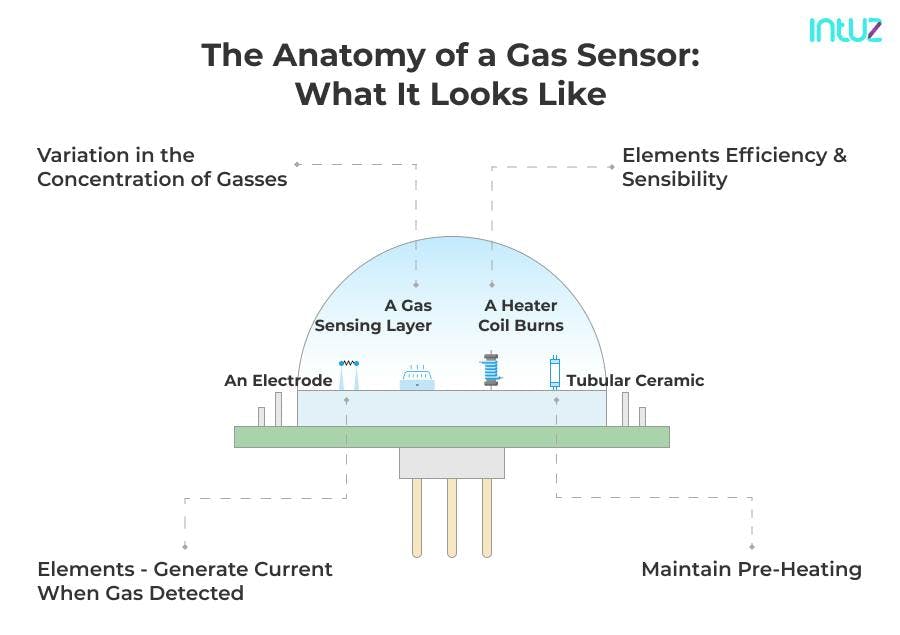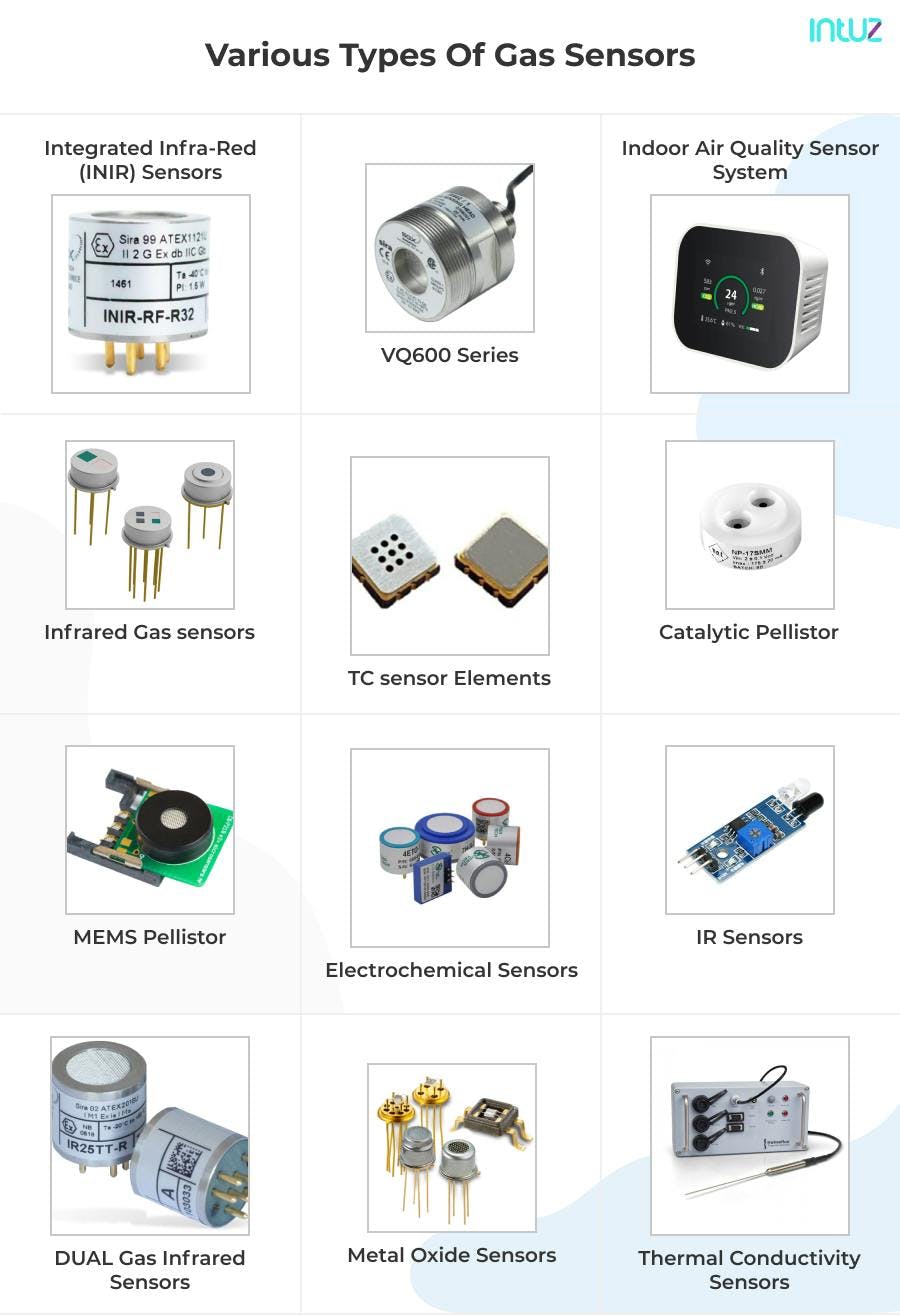Table of Content
As the name suggests, gas detection refers to identifying and monitoring gasses at potentially dangerous levels with the help of gas detection monitoring devices.
In healthcare, automotive, transportation, utilities and energy industries, gas detectors are used in a broad scope of practices and use cases. Gas leakage detectors rely upon sensors to sense or detect the presence of dangerous gasses and provide ample warning to those in charge.
Gas sensors detect the presence and concentration of various hazardous gasses such as explosive gasses, Volatile Organic Compounds (VOCs), odor, humidity and so on.
Common types of gas sensors include photoionisation (PID) sensors, semiconductor sensors, electrochemical sensors, infrared sensors, and so on. These sensors come in various formats for meeting the unique demands of different gas monitoring applications.
In this article, we will look at the types of gas sensors in use, how they work and their main characteristics, and the anatomy of a gas sensor. Without further ado, let us begin:
What are gas sensors?
The human nose has natural sensors that detect over 1 trillion distinct odors. However, it is still not sufficient to label or identify gasses in the atmosphere. Devices such as gas sensors are required to identify and calculate the concentration of different gasses in a specified region.
They help detect toxic gasses and prevent mishaps due to them. Several types of gas sensors are based on the gas to be detected. The most common ones are useful for detecting oxygen, carbon dioxide, nitrogen, and methane.
CO2 sensors are helpful for various applications, including environmental monitoring, industrial safety, and security. A gas sensor is mainly used to detect multiple gasses in the atmosphere.
It is a device that responds to the concentration of gasses (in parts per million or ppm) in the environment where it is installed. The device works by creating a potential difference by altering the material's internal sensor's resistance.
Enhance Your IoT System with Advanced Gas Sensing Solutions!
Explore servicesThe phenomenon is reflected by the output voltage, which, in turn, helps in detecting the concentration along with the type of gas. Now, a single sensor cannot detect all kinds of gasses. The material within the sensor determines the kind of gas it can detect.
These sensors are available as modules with differential comparators. The comparators may be industrial-grade depending upon their usage. Gas sensors can be configured for a specific gas concentration or a threshold value.
Its digital pin swings high when the gas concentration surpasses this level. The gas concentration may be determined using the analog pin. The sensing element of the sensors comprises a heater coil, electrode, gas sensing layer, tubular ceramic, and electrode line.
These sensors are usually vapor-sensitive polymers, semiconducting metal oxides, and other absorbent materials. These sensors are of six types based on the sensing element:
Optical gas sensor
Calorimetric gas sensor
Acoustic-based gas sensor
Electrochemical gas sensor
Metal Oxide-based gas sensor
Capacitance-based gas sensor
How do gas sensors detect gas?
Gas detectors typically use the scaling system to detect harmful gasses. As a dangerous gas exceeds its base level and reaches the threshold limit of the scale, the alarm triggers. Combustible and toxic gasses are the main types that gas sensors detect.
Catalytic sensors can identify combustible gasses. As the concentration of gas at a place increases and it touches the catalytic surface, it causes a change in resistance and thus the alarm sounds off.
Furthermore, an infrared sensor, which is also a light detector, can identify the kind of gas if it travels into the light pathway between the transmitter and receiver. An infrared sensor also detects combustible materials.
Electrochemical sensors are primarily employed to find harmful gasses by producing signals on the electrode. The sensors are tremendously sensitive and are used explicitly for detecting carbon monoxide. These sensors come with a digital display to give the output.
Another method for identifying harmful gasses is metal oxide semiconductors. In this method, a sensitive film is used, which reacts with the toxic and explosive gasses when the threshold limit exceeds. Moreover, these sensors also work well in low humidity conditions.
The anatomy of a gas sensor: What it looks like

Like every technological device, a sensor is made up of many elements - each having its purpose:
- A gas sensing layer is the primary component in the sensor. It is used for sensing the variation in the concentration of gasses and accordingly generating the change in electrical resistance.
- A heater coil burns-in the sensing element so that the efficiency and sensitivity of the sensing element increases. It is usually made of nickel chromium with a high melting point so it can stay heated up without melting.
- An electrode line because the sensing element generates a tiny current when the gas is detected. It is vital to maintain the efficiency of carrying those small currents. This is where platinum wires help in moving the electrons efficiently.
- An electrode is a central hub from where the output of the sensing layer gets connected to the electrode line. The arrangement allows the output current to flow to the required terminal.
- A tubular ceramic is placed between the gas sensing layer and the heating coil. It helps maintain the sensing layer's pre-heating, giving the sensing layer high sensitivity to get efficient output current.
Specifications of gas sensors
The metal oxide-based gas sensor is one of the most commonly used gas sensors for smoke detection and toxic identification. It employs a chemiresistor that comes in contact and reacts with target gasses such as hydrogen and carbon monoxide. Following are the key specifications of gas sensors:
- Poisoning immune and fail-safe operation
- Continuous sampling of diffused gas via a mesh
- Can be used in both fixed and portable functions
- A wide range of gasses or vapors can be detected
- Low consumption of power and quicker response rate
- Stable signal levels through special gold plated optical or gas cavity
- Stainless steel construction for robustness and corrosion resistance
- Low maintenance with no mobile parts and mechanical shock resistance
- Works efficiently even in varying ambient temperatures, pressures, and humidities
Various types of gas sensors
As we have discussed before, gas sensors are electronic devices for identifying different gasses. They are commonly used to detect explosive or toxic gasses and measure gas concentration. These sensors are employed in manufacturing units and factors to identify gas leaks and detect carbon monoxide.

They could be a part of a more extensive embedded system such as security and hazmat equipment normally connected to an audio interface or audible alarm. Without wasting much time, let us study the top 12 types of gas detectors in detail:
1. IR sensors
The NDIR principle, also employed in the sensortech line of small infrared gas sensors, is used in the IR600 Series gas sensors to detect and monitor the presence of CO2, hydrocarbons, and acetylene. As a means of compensating for background noise, dual detector channels are used.
To account for temperature, literally a temperature sensor is installed. With stationary gas detection systems, IR600 sensors are intended to be integrated. They are built with a flameproof stainless steel casing and a stainless steel sinter integrated for the safe entry of the testing gasses. The following gasses can be detected with the help of IR sensors:
- Acetylene
- Hydrocarbons
- Carbon monoxide
2. VQ600 Series
The 0 to 100% LEL for combustible gasses and 0 to 100% volume in thermal conductivity mode when employing the family of pellistor gas sensors are the detection and monitoring ranges for the VQ600 Series.
The VQ600 Series is made to function as a crucial component of a stationary gas detection system. The head includes a flameproof cage made of stainless steel with an integrated stainless steel sinter that enables secure entry into the atmosphere being tested. VQ600 Series is useful for the detection of the thermal conductivity in gas and spots the following:
- Flammable substances (Catalytic sensors)
- Thin gasses (e.g. hydrogen and helium)
3. MEMS pellistor
A new generation of low-power, reliable sensors for detecting combustible gasses, mainly methane, has been developed, and one of them is called the MPEL. It is a Micro Electro Mechanical System (MEMS) pellistor well-suited for industrial use.
Innovative process technologies, combined with superior sensor and filter materials, create sensors that outdo competing products in terms of performance. Compared to current pellistor gas sensors, these devices can significantly reduce power by up to 50% in continuous operation. The top features of an MEMS pellistor are:
- Low power
- High shock resistance
- Compatible with packaging
- Extremely high resistance to HMDS and H2S poisoning
4. Catalytic pellistors
Catalytic pellistors are solid-state devices that identify combustible gasses with markedly different thermal conductivity from the air.
The term "pellistor" is a combination of the words "pellet" and "resistors" because the detecting elements are small ceramic "pellets" loaded with catalysts whose resistance changes in the presence of the target gas.
Catalytic pellistors are IoT sensors that can identify flammable gasses and vapors in the air at potentially explosive concentrations. They are currently operating in a catalytic mode, which burns the target gas while measuring the heat released by the sensor.
The top features of a catalytic pellistors are:
- Simple circuitry
- Variants immune to shock and poison
- Responsive to a variety of flammable gasses
- Varied operating voltages and sensor types available
IoT Device Management: Importance, Challenges, Solutions
Learn More5. TC sensor elements
Since hydrogen has the highest thermal conductivity of any known gas, the TC-1326 MEMS thermal conductivity sensor is a low-power, very durable device that detects hydrogen. By increasing thermal conductivity of the hydrogen-air mixture, it is consequently possible to detect low hydrogen concentrations in the air.
The top features of TC sensor elements are:
- Impact of low orientation
- Low power, battery-operated design
- Small-size superior shock tolerance to mechanical shocks
6. Infrared gas sensors
Infrared gas sensors are appropriate for portable instrumentation where shorter-term usage is more common. They are designed for continuous sensing of CO2 and many hydrocarbon gasses, including vapors in permanent systems.
The entire body construction is explosion-proof to ATEX, CSA, and UL requirements, and the metal mesh gas entrance aperture also serves as a flame arrestor. The series-4 size offers interoperability with various electrochemical and catalytic sensors in multi-gas instrumentation.
7. Metal oxide gas sensors
The exclusive MOS technology combines a patented poly-silicon heater and a specialized nano-particle sensing layer. It makes use of cutting-edge MEMS technology.
This innovative design produces a susceptible semiconductor sensor using an automobile production line for superior quality and responsiveness.
The fundamental tenet of metal oxide sensors is that the presence of target gasses causes a change in the resistance of the detecting layer in the sensor.
Resistance will rise in the presence of oxidizing gasses such as ozone or nitrogen dioxide and fall in the presence of reducing gasses like carbon monoxide or Volatile Organic Compounds (VOCs).
One of the main benefits of the sensor is that it uses less energy than other types to heat and operate. The top features of metal oxide gas sensors are:
- Extremely sensitive
- Minimal heater current
- A broad range of detection
- High resilience to vibrations and shocks
8. DUAL gas infrared sensors
The infrared sensors use the well-established NDIR principle to find and keep track of the presence of gasses. One can detect individual gasses or different types of gas.
Their concentrations can be calculated, using an infrared source and precise filtering on the pyroelectric detectors positioned inside the optical/gas cavity.
In general, it is helpful in safety applications where the sensor size is constrained and a flameproof housing is necessary for hazardous settings. These sensors are appropriate for the trustworthy monitoring of gas levels. Dual gas infrared sensors help in the detection of:
- Hydrocarbons
- Carbon dioxide
- Hydrocarbons mixtures
9. Electrochemical gas sensors
Electrochemical gas sensors create a chemical reaction between the gas and oxygen inside the sensor to detect gasses. The amount of gas present determines how much of a tiny current is generated by this reaction.
Reactions on two electrodes occur that, when combined, lead to the sensing process. These electrodes are made up of tiny discs of porous PTFE with a thin coating of a catalytic metal. The advantages of electrochemical gas sensors are.
- Extremely energy-efficient
- Display positive reactions to various gas quantities in different environmental situations
- Carbon monoxide, hydrogen sulfide, and oxides of nitrogen and sulfur are just a few dangerous gasses that can be detected by a range of 20mm electrochemical gas sensors.
10. Thermal conductivity sensors
Catalytic pellistors cannot be used to monitor gas levels over the Lower Explosive Limit (LEL) since they measure flammability. The diminishing oxygen level will generate a fall-off signal. The thermal conductivity pellistor, a similar device, can be used to track these high gas levels.
Temperature sensitivity (TC) pellistors are devices that detect and measure thermal conductive gasses, which are significantly different from a reference gas, often air, between 0 and 100% by volume. Thermal conductive gasses include hydrogen, helium, and methane, as examples.
The temperature of the gas can affect this discrepancy. Coal mining and natural gas monitoring are the principal uses for methane-calibrated thermal conductivity pellistors.
11. Indoor air quality sensor system
Indoor air quality has traditionally been affected by temperature, humidity, and CO2. Our daily inhalations of indoor air have a significant impact on both our health and productivity.
It has been proven that VOCs are bad for people's health. Indoor air quality, therefore, has a significant impact on the inhabitants' comfort, health, and well-being.
The places where air quality has to be monitored and controlled are most likely to include automobiles, trucks, buses, hospitals, schools, offices, and industrial facilities.
In this setting, inhabitants spend a significant amount of time in the same environment daily. The sensor enables automatic ventilation management to provide the best air quality.
12. Integrated Infra-Red (INIR) sensors
The INIR sensor was created by utilizing cutting-edge technology, using a microcontroller with an ARM7 core, and implementing the appropriate software design methodologies to boost the device's reliability and reduce the likelihood of errors.
The sensor is intended to speed up installation and hence boost productivity. The INIR sensor requires embedded software and hardware to run on a low-voltage DC power source.
The sensor will transform the unprocessed readings into a linear, temperature-corrected signal proportionate to the applied gas concentration. Both a digital and analog version of the output signal is available.
Let's Build an IoT Application for Smart Gas Detection!
Contact UsOver to you
If you are particularly looking to select a gas sensor, it is vital to note that not all sensors are designed for equal performance or serve the same purpose.
A gas sensor well-suited for measuring indoor air quality or carbon dioxide levels is unlikely to help measure the gas concentrations required for fire suppression testing.
If you want to build a gas sensor or kickstart an IoT app development project in the oil and gas space, you have come to the right place. We have all the resources, expertise, and knowledge to undertake anything you throw our way. Intrigued to know more?
Book a Free 45-minute Consultation with Our IoT Experts Today! Get a customized roadmap and strategies to leverage and integrate IoT gas sensors for effective monitoring.






